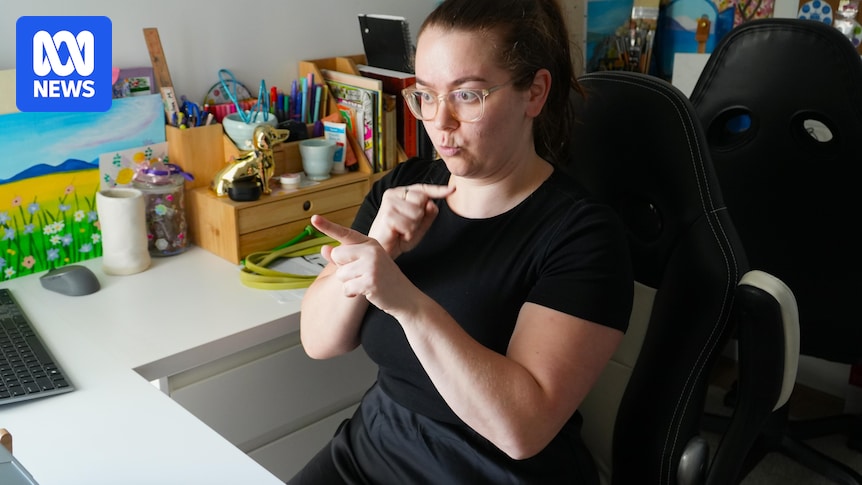Brittany Manifis recently became a certified Auslan interpreter, and she’s been inundated with work in Perth’s deaf community ever since.
But it nearly didn’t happen.
The first time she tried to get certified, she failed the test – which happens to more than half of all people who attempt it, according to the National Accreditation Authority for Translator and Interpreters (NAATI).
It comes as Australia grapples with a shortage of Auslan interpreters.
Brittany Manifis says making the test to become an Auslan interpreter easier is not the answer. (ABC News: Ruby Littler)
Members of the deaf community are calling for more government funding to help incentivise the profession.
‘Not an easy fix’
Ms Manifis said making the test easier isn’t not the solution.
“You need that particular drive to become an interpreter,” she said.
“It is a tough gig, not just the test, but also as a profession.”
Ms Manifis said her TAFE classes would often be postponed because the college couldn’t find the appropriate staff to teach.
Brittany recently became a certified Auslan interpreter. (ABC News: Ruby Littler)
“Because there wasn’t that education, I couldn’t advance,” Ms Manifis said.
“It’s not an easy fix … a lot of the time (educators) are prioritised to be interpreters for the community, as opposed to interpreter educators. They’re very stretched.”
Currently there are 747 interpreters with a valid Auslan certification, but according to the latest census, around 16,000 people use Auslan at home, including the children of deaf adults.
The disability royal commission recommended state and territories start implementing a strategy to increase the quality and quantity of AUSLAN Interpreters by January 2025.
But a national plan to tackle the shortage is not bound by that deadline.
‘Life and death decisions’
It’s people like Drisana Levitzke-Gray and her daughter Steorra who are affected.
Auslan is how they communicate.
In life-threatening situations, like her daughter’s traumatic birth, well-educated interpreters were crucial.
“I needed to have the medical information of what was going on … doctors were coming and going nurse were coming and going,” Ms Levitzke-Gray said.
Drisana Levitzke-Gray and her daughter Steorra use Auslan to communicate. (ABC News: Ruby Littler)
“So you can imagine how overwhelming it was.”
Not just any interpreter could help in this situation.
Ms Levitzke-Gray cited “terminology issues” and said there were “life and death decisions to be made”.
She was grateful to have a rotation of interpreters she trusted.
Ms Levitzke-Gray said deaf people could help hearing people learn their language — but accessibility issues within the education sector often proved too great a barrier.
“I did law at uni and I found that easier than doing a Cert 4 (in Auslan) … can you imagine that?” she said.
Drisana Levitzke-Gray wants the government to make it easier for deaf people to become Auslan instructors. (ABC News: Ruby Littler)
“(People) say we need more interpreters, we need to reduce the price and cost of the course,” she said.
“But you need to have the right teachers to be able to teach them to become great interpreters.”
High standards crucial
Over three-quarters of deaf Australians said the main reason they can’t access interpreters is the lack of qualified workers, according to Australia’s 2022 Deaf Census.
“When it comes to booking interpreters, you have to book them well in advance, because a lot of the time, if you do it last minute, there’s not going to be anyone that’s available,” Ms Manifis said.
There are likely people working without a certification, but peak bodies stress the importance of the formalised assessment process.
NAATI’s WA representative, Kym McDowell, agrees it’s not a perfect system but said compromising standards shouldn’t be the cost.
Kym McDowell works with the National Accreditation Authority for Translators and Interpreters in WA. (ABC News: Ruby Littler)
“It’s not hard to find instances where people have been given the wrong information,” she said.
“Surgical procedures [for instance], you don’t want to get the wrong leg cut off.
“Nobody’s really trying to hide the fact that it’s a difficult test.
“It has a high standard, and it’s for the protection of the people who require the service.”
People wishing to be certified in Auslan must complete a NAATI-endorsed TAFE course.
There are 747 certified Auslan interpreters in Australia. (ABC News: Ruby Littler)
NAATI then assesses their ability to communicate between the two languages (English and Auslan) by simulating various situations.
Incentivising the profession
WA chair of the Australian Sign Language Interpreters Association, Adrian Chia, believes young people don’t consider Auslan interpreting as a future job prospect.
“Auslan interpreting doesn’t quite carry the prestige of other roles, like a doctor or a lawyer, even though we study for just as long in a lot of cases,” he said.
“Ideally, if Auslan and interpreting were offered at a university level, perhaps you would see a larger number of people going on to become interpreters.”
There also needs to be more incentives to encourage existing interpreters to make the transition to teaching, according to Mr Chia.
“It’s not advertised as a career pathway,” Mr Chia said.
“Some people prefer to just stay working as an interpreter and not become a trainer … it’s not a highly desirable position (teaching) because it’s not paid particularly well.”
Loading
